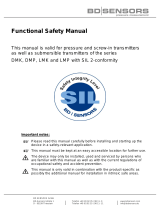
4 Commissioning
4.1 Safety Instructions
See chapter 2 Safety for general safety instructions.
4.2 Activation of STO
The STO function is activated by removing the voltage at
terminal 37 of the frequency converter. By connecting the
frequency converter to external safety devices providing a
safe delay, an installation for a Safe Stop 1 can be
obtained. External safety devices need to fulfill Cat./PL or
SIL when connected to terminal 37. The STO function can
be used for asynchronous, synchronous, and permanent
magnet motors.
When the STO function (terminal 37) is activated, the
frequency converter issues an alarm, trips the unit, and
coasts the motor to a stop. Manual restart is required. Use
the STO function to stop the frequency converter in
emergency stop situations. In normal operating mode
when STO is not required, use the standard stop function
instead. Ensure that requirements according to ISO 12100
paragraph 6.3.3.2.5 are fulfilled before using the automatic
restart function.
4.3
Parameter Settings for STO in
Combination with VLT
®
PTC Thermistor
Card MCB 112
When MCB 112 is connected, additional selections are
available for 5-19 Terminal 37 Safe Stop ([4] PTC 1 Alarm to
[9] PTC 1 & Relay W/A).
•
Selections [1]* Safe Stop Alarm and [3] Safe Stop
Warning are still available, but are for installations
without MCB 112 or any external safety devices.
If [1]* Safe Stop Alarm or [3] Safe Stop Warning are
selected and MCB 112 is triggered, the frequency
converter reacts with an alarm Dangerous Failure
[A72] and coasts the motor safely, without
automatic restart.
•
Selections [4] PTC 1 Alarm and [5] PTC 1 Warning
are not to be selected when an external safety
device is used. Those selections are for when only
MCB 112 uses the STO.
If selection [4] PTC 1 Alarm or [5] PTC 1 Warning is
selected and the external safety device triggers
STO, the frequency converter issues an alarm
Dangerous Failure [A72] and coasts the motor
safely, without automatic restart.
•
Select [6] PTC 1 & Relay A to [9] PTC 1 & Relay W/A
for the combination of external safety device and
MCB 112.
CAUTION
Selections allow for automatic restart when the external
safety device is de-activated.
Before selecting [7] PTC 1 & Relay W or [8] PTC 1 & Relay
A/W, ensure that:
•
The unintended restart prevention is
implemented by other parts of the STO instal-
lation, or
•
A presence in the dangerous zone can be
physically excluded when STO is not activated.
In particular, paragraph 6.3.3.2.5 of ISO
12100:2010 must be observed.
See VLT
®
PTC Thermistor Card MCB 112 Operating
Instructions for further information.
4.4 Automatic/Manual Restart Behaviour
By default the STO function is set to unintended restart
prevention behaviour. To terminate STO and resume
normal operation:
1. Reapply 24 V DC supply to Terminal 37.
2. Give a reset signal (via Bus, Digital I/O, or [Reset]
key).
Set the STO function to automatic restart by setting the
value of 5-19 Terminal 37 Safe Stop from default value [1]*
Safe Stop Alarm to value [3] Safe Stop Warning.
Automatic restart means that STO is terminated, and
normal operation is resumed, as soon as the 24 V DC is
applied to terminal 37. No reset signal is required.
4.5
STO Commissioning Test
After installation and before first operation, perform a
commissioning test of the installation, using STO.
Perform the test again after each modification of the
installation or application involving the STO.
NOTICE
A succesful commissioning test of the STO function is
required after the initial installation, and after each
subsequent change to the installation.
Commissioning Operating Instructions
MG37D202 Danfoss A/S © 09/2014 All rights reserved. 9
4 4
















